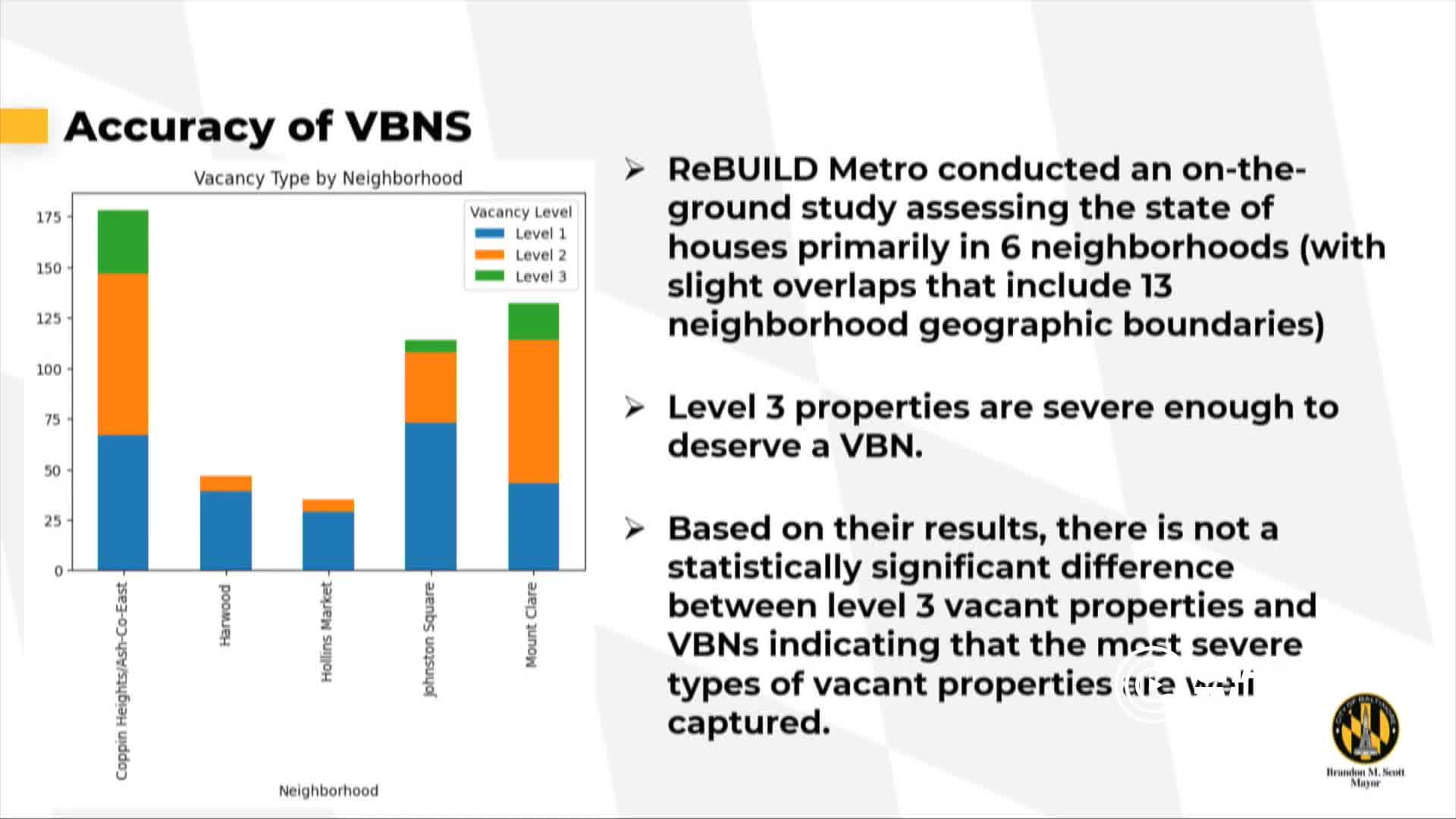Baltimore Council Discusses Challenges with Vacant Building Notices and Unoccupied Properties
October 01, 2025 | Baltimore City, Baltimore County, Maryland
This article was created by AI summarizing key points discussed. AI makes mistakes, so for full details and context, please refer to the video of the full meeting. Please report any errors so we can fix them. Report an error »

In the heart of Baltimore City Hall, the Housing and Economic Development Committee convened on September 30, 2025, to address pressing issues surrounding vacant properties and the city's approach to managing them. The meeting, marked by a blend of urgency and collaboration, highlighted the complexities of issuing Vacant Building Notices (VBNs) and the challenges faced by residents living near these properties.
Deputy officials, including Deputy Hessler and Deputy Booker, presented findings from a recent study conducted by Rebuild Metro, which examined vacant properties across six neighborhoods. The study revealed that there was no statistically significant difference between properties with VBNs and those without, suggesting that the most severely neglected buildings were being identified and addressed. This insight sparked discussions about the thresholds for issuing VBNs, which are crucial for the city’s legal proceedings related to property management.
The committee members expressed concerns about the varying conditions of unoccupied properties, some of which are well-maintained by neighbors while others languish in disrepair. The deputies emphasized the importance of maintaining clear definitions for what constitutes a vacant building, noting that properties must be both unoccupied and deemed unsafe or unfit for habitation to qualify for a VBN. This definition is vital for legal enforcement and helps the city navigate the complexities of property rights and due process.
Council members voiced frustrations over the bureaucratic hurdles that often prevent timely action on properties that clearly need attention. One councilwoman highlighted the difficulties residents face when trying to report issues with vacant buildings, noting that many feel compelled to repeatedly file complaints without seeing results. The discussion underscored the need for a more streamlined process to address these concerns, particularly in neighborhoods plagued by high grass, weeds, and other sanitation issues.
As the meeting progressed, the conversation shifted to the challenges of managing commercial properties. Council members pointed out that while residential properties might meet the criteria for VBNs, many commercial buildings remain in disrepair without sufficient action being taken. The deputies acknowledged the need for a more proactive approach to address these vacant storefronts, which often detract from the vibrancy of local communities.
The committee also discussed the importance of auditing the VBN list to ensure that properties are being monitored effectively. With over 113,000 inspections conducted this year alone, the deputies recognized the strain on resources and the necessity of prioritizing properties that pose safety risks to residents.
In closing, the meeting served as a critical platform for addressing the ongoing challenges of vacant properties in Baltimore. The discussions illuminated the need for clearer definitions, better communication with residents, and a more efficient system for managing both residential and commercial vacancies. As the city grapples with these issues, the commitment to improving the quality of life for all residents remains at the forefront of the council's agenda.
Deputy officials, including Deputy Hessler and Deputy Booker, presented findings from a recent study conducted by Rebuild Metro, which examined vacant properties across six neighborhoods. The study revealed that there was no statistically significant difference between properties with VBNs and those without, suggesting that the most severely neglected buildings were being identified and addressed. This insight sparked discussions about the thresholds for issuing VBNs, which are crucial for the city’s legal proceedings related to property management.
The committee members expressed concerns about the varying conditions of unoccupied properties, some of which are well-maintained by neighbors while others languish in disrepair. The deputies emphasized the importance of maintaining clear definitions for what constitutes a vacant building, noting that properties must be both unoccupied and deemed unsafe or unfit for habitation to qualify for a VBN. This definition is vital for legal enforcement and helps the city navigate the complexities of property rights and due process.
Council members voiced frustrations over the bureaucratic hurdles that often prevent timely action on properties that clearly need attention. One councilwoman highlighted the difficulties residents face when trying to report issues with vacant buildings, noting that many feel compelled to repeatedly file complaints without seeing results. The discussion underscored the need for a more streamlined process to address these concerns, particularly in neighborhoods plagued by high grass, weeds, and other sanitation issues.
As the meeting progressed, the conversation shifted to the challenges of managing commercial properties. Council members pointed out that while residential properties might meet the criteria for VBNs, many commercial buildings remain in disrepair without sufficient action being taken. The deputies acknowledged the need for a more proactive approach to address these vacant storefronts, which often detract from the vibrancy of local communities.
The committee also discussed the importance of auditing the VBN list to ensure that properties are being monitored effectively. With over 113,000 inspections conducted this year alone, the deputies recognized the strain on resources and the necessity of prioritizing properties that pose safety risks to residents.
In closing, the meeting served as a critical platform for addressing the ongoing challenges of vacant properties in Baltimore. The discussions illuminated the need for clearer definitions, better communication with residents, and a more efficient system for managing both residential and commercial vacancies. As the city grapples with these issues, the commitment to improving the quality of life for all residents remains at the forefront of the council's agenda.
View full meeting
This article is based on a recent meeting—watch the full video and explore the complete transcript for deeper insights into the discussion.
View full meeting
